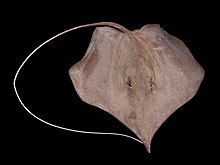
Myliobatiformes is one of the four orders of batoids, cartilaginous fishes related to sharks. They were formerly included in the order Rajiformes, but more recent phylogenetic studies have shown the myliobatiforms to be a monophyletic group, and its more derived members evolved their highly flattened shapes independently of the skates.

Dasyatis is a genus of stingray in the family Dasyatidae that is native to the Atlantic, including the Mediterranean. In a 2016 taxonomic revision, many of the species formerly assigned to Dasyatis were reassigned to other genera.

Himantura is a genus of stingray in the family Dasyatidae that is native to the Indo-Pacific. In a 2016 taxonomic revision, many of the species formerly assigned to Himantura were reassigned to other genera.
The Colares stingray, Dasyatis colarensis, is a species of stingray in the family Dasyatidae, native to the shallow brackish waters of the Amazon River estuary in northern Brazil. This species inhabits inshore bays during the dry season and moves away from the coast in the rainy season. It is characterized by a rhomboid pectoral fin disk, elongated snout, and a dark band on the lower lip. A fairly large species, males and females attain disk widths of 63 cm (25 in) and 91 cm (36 in) respectively. Females give birth to 1–4 young, possibly annually. Colares stingrays are both targeted and caught as bycatch by Brazilian artisanal and commercial fisheries; these pressures coupled with its small range and slow reproductive rate has led the International Union for Conservation of Nature (IUCN) to list this species as Vulnerable.
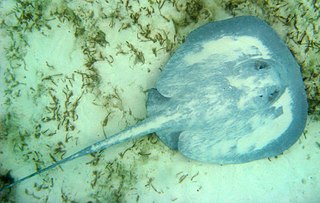
The chupare stingray or Caribbean whiptail stingray, Styracura schmardae, is a species of stingray in the family Potamotrygonidae, found in the western Atlantic Ocean from the Gulf of Campeche to Brazil, including the Antilles. The presence of this species in the Gulf of Mexico has not been confirmed. It also occurs in the Bahamas. It usually inhabits sandy substrates, sometimes near coral reefs, and is an infrequent visitor to the Amazon River estuary. Leonard Compagno doubted the taxonomic validity of this species in his 1999 Checklist of Living Elasmobranchs.

Urogymnus is a genus of stingrays in the family Dasyatidae from marine, brackish and freshwater habitats in the Indo-Pacific and tropical East Atlantic regions. The genus was previously considered to be monotypic, containing only the porcupine ray. Molecular phylogenetic research published in 2016 reassigned several species from Himantura to Urogymnus.

The whiptail stingrays are a family, the Dasyatidae, of rays in the order Myliobatiformes. They are found worldwide in tropical to temperate marine waters, and a number of species have also penetrated into fresh water in Africa, Asia, and Australia. Members of this family have flattened pectoral fin discs that range from oval to diamond-like in shape. Their common name comes from their whip-like tails, which are much longer than the disc and lack dorsal and caudal fins. All whiptail stingrays, except the porcupine ray, have one or more venomous stings near the base of the tail, which is used in defense. They range in size from 0.18 to 2.0 m or more across.

The Pacific chupare or Pacific whiptail stingray, Styracura pacifica, is a species of stingray in the family Potamotrygonidae. It has been reported off the Pacific coast of Central America from Oaxaca, Mexico to Costa Rica, and also around the Galapagos Islands. It is usually found in shallow water on soft silty or muddy flats; it is unknown whether this species is tolerant of low salinity like the related chupare stingray. Leonard Compagno doubted the taxonomic validity of this species in his 1999 Checklist of Living Elasmobranchs.

Taeniura is a genus of stingrays in the family Dasyatidae. The species Taeniurops grabata and T. meyeni were formerly placed in this genus. However, phylogenetic research has shown that these two species are not closely related to T. lymma, and they have been assigned to a separate genus, Taeniurops.

The pitted stingray is a species of stingray in the family Dasyatidae, endemic to the waters around Japan and the Sea of Japan. It typically found near the coast at depths of 40–60 m (130–200 ft), but may also venture into the open sea. Measuring up to 1.2 m (3.9 ft) across, the pitted stingray has a diamond-shaped pectoral fin disc with a characteristic "W"-shaped groove on the underside. Other identifying characteristics of this species include its dark gray dorsal coloration with small white spots, and the presence of dorsal tubercles in adults. Pitted stingrays are caught as bycatch in coastal fisheries and brought to market. The International Union for Conservation of Nature (IUCN) does not yet have sufficient data to assess this species beyond Data Deficient.
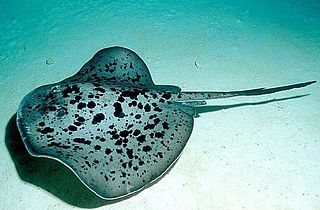
Taeniurops is a genus of stingrays in the family Dasyatidae. Its two species were formerly contained within the genus Taeniura.

Bathytoshia is a genus of stingrays in the family Dasyatidae found worldwide in tropical and warm temperate oceans. It was formerly regarded as a junior synonym of the genus Dasyatis.

Hemitrygon is a genus of stingrays in the family Dasyatidae from marine, brackish and freshwater habitats in the central Indo-Pacific and northwest Pacific regions. The genus was formerly regarded as a junior synonym of the genus Dasyatis.

Hypanus is a genus of stingrays in the family Dasyatidae from warmer parts of the East Pacific and Atlantic, including the Caribbean and Gulf of Mexico. The genus was previous regarded as a junior synonym of the genus Dasyatis.

Telatrygon is a genus of stingrays in the family Dasyatidae from the central Indo-Pacific. Its species were formerly contained within the genus Dasyatis.
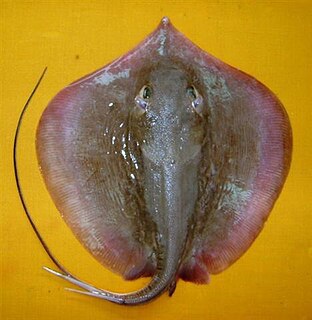
Brevitrygon is a genus of stingrays in the family Dasyatidae from the Indo-Pacific. Its species were formerly contained within the genus Himantura.
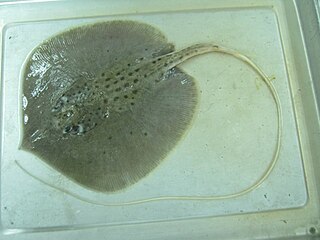
Fluvitrygon is a genus of stingrays in the family Dasyatidae from freshwater in southeast Asia. Its species were formerly contained within the genus Himantura.

Maculabatis is a genus of stingrays in the family Dasyatidae from the Indo-Pacific. Its species were formerly contained within the genus Himantura.

Pateobatis is a genus of stingrays in the family Dasyatidae from the Indo-Pacific. Its species were formerly contained within the genus Himantura.

Styracura is a genus of stingray in the family Potamotrygonidae and the only genus in the subfamily Styracurinae. The two species in this genus were formerly included in Himantura, but were moved to Styracura in 2016 based on morphology and molecular evidence. Unlike other members of the family Potamotrygonidae, also known as freshwater stingrays, Styracura are found in the tropical West Atlantic and East Pacific.
